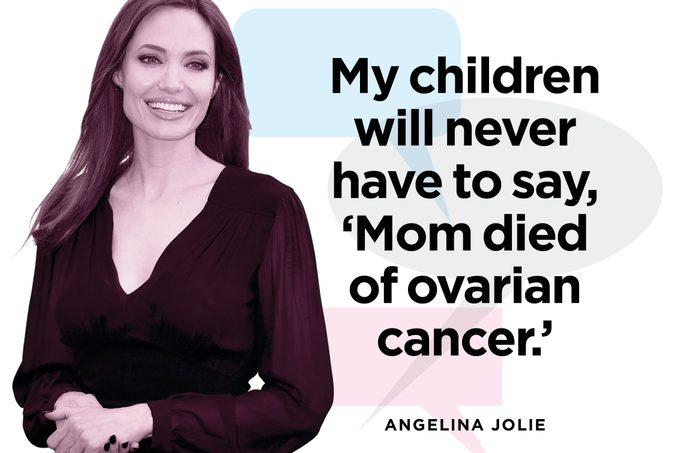5 Surprising Facts You Didn’t Know About Breast- and Ovarian-Cancer Genes
Updated: Mar. 02, 2023
Here's what you may not know about BRCA genes and what goes into the decisions thousands of women make every year after they take the genetic test.

Filmmaker Angelina Jolie revealed in a March 2015 New York Times op-ed that she had her ovaries removed after tests discovered potential early markers of ovarian cancer, the disease her mother died from in 2007. A carrier of the breast- and ovarian-cancer gene BRCA1, Jolie had a double mastectomy in 2013 to reduce her risk of developing breast cancer.
“It is not easy to make these decisions,” Jolie wrote about her 2015 surgery. “But it is possible to take control and tackle head-on any health issue. You can seek advice, learn about the options and make choices that are right for you. Knowledge is power.”
It’s important to understand why some people with a BRCA gene choose to have a mastectomy and/or oophorectomy—and why it may or may not be right for others.
Most cases of breast cancer are completely random—not due to BRCA genetic mutations
BRCA1 and BRCA2 genes are types of tumor suppressors. When they function normally, they help prevent uncontrolled cell growth that can lead to malignant tumors. When the BRCA genes have faulty mutations, they can lead to the development of hereditary breast and ovarian cancer, according to the American Cancer Society.
Breastcancer.org states that just 5 to 10 percent of all cases of breast cancer are believed to be hereditary, The overwhelming majority of people with breast cancer do not have BRCA mutations.
Most women don’t need genetic testing
Wondering whether you should be tested for mutated BRCA genes? Only women who have an increased risk due to certain patterns of family cancer benefit from testing.
Breastcancer.org says that it’s important to focus on the right relatives before jumping to conclusions about your family’s cancer history. It recommends the following criteria:
• Look at the health history of first-degree relatives (parents, siblings, children) and second-degree relatives (grandparents, aunts, uncles, nieces, nephews).
• You may want to consider getting tested for BRCA genes if one or more (on the same side of the family) were diagnosed with the same kind of cancer (two breast cancers, two ovarian cancers, for example), a BRCA1 or BRCA2 mutation, breast or ovarian cancer before age 50, both breast and ovarian cancer, or male breast cancer.
• People who are of Ashkenazi (Eastern European) Jewish descent and have one or more relatives who fit the the diagnoses above may have high risk of having a BRCA mutation.
The BRCA mutations are detected with a blood test through a lab that specializes in the screening and results can take a few weeks.
Not everyone with a BRCA gene mutation will develop cancer
Defective BRCA genes can raise the risk of breast and ovarian cancer dramatically. Women who have a BRCA1 and/or BRCA2 mutation can have up to a 72 percent higher risk of being diagnosed with breast cancer during their lifetimes compared with women who don’t have them, according to a study in JAMA.
That’s why some experts believe that the decision to prophylactically remove both breasts, as Jolie did, as well as the ovaries, could be an option for someone who tests positive for these mutations.
But not everyone who tests positive for BRCA mutations has the same exact elevated risk of breast and ovarian cancer. Risks can vary widely, and some patients may be more comfortable with watching and waiting than having surgery, explains Heather Hampel, associate director, Division of Human Genetics at The Ohio State University Comprehensive Cancer Center in Columbus
The highest risk family member may want to get tested first
If cancers run in your family, the family member with the highest risk of having a mutation might consider getting tested first (but of course it’s a highly personal decision about whether to have the test). That might be someone who was already diagnosed with breast or ovarian cancer at a young age, usually before 40. “Start with the person who has cancer if that person is still alive and willing to be tested and then test at-risk relatives if you find the mutation, Hampel says. At-risk relatives may include siblings, parents, close aunts uncles and grandparents. “Every woman with ovarian cancer and everyone with pancreatic cancer warrants gene testing and all men with metastatic or spreading prostate cancer consider gene testing as BRCA mutations are also common in these cancers,” she says. Experts recommend anyone considering genetic testing for breast or ovarian cancer should work with a genetic counselor who can help weigh the complex upsides and downsides of testing and treatments.
The test is less expensive than in the past, and insurance may cover it
“BRCA testing can be as low as $250 today,” Hampl says. “It used to be close to $4,000.” Most insurers will cover the costs of testing in individuals who meet certain criteria.













